|
Famous Names in American Clock Companies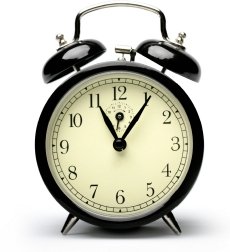
By 1700 there were so many clocks in the colonies that it attracted young, recently trained clockmakers. They mostly set up shop in Boston and Philadelphia because that's where most of the wealthy and upper middle class people were, and these were the only people owning clocks at that time. Later, craftsmen opened shops in New York, Rhode Island, Connecticut, and Maryland. During that time, those early mechanical clocks were handcrafted one clock at a time in the ways of the old world. The clocks of the 1700's and early 1800's were almost entirely tall clocks or grandfather clocks They were hand crafted in many different styles. Usually, the clock movement was made by the clockmaker, and the case made later by a cabinet maker. Later, around 1800, many less expensive tall clocks were made with wooden movements instead of brass. At that time, brass had to be imported and was expensive. The clockmakers wanted a larger market to sell to, so they used the wood movements so the middle class could afford to own a clock. After about 1830, clockmakers started to make smaller shelf, or mantel clocks. Most of these had wooden movements and were weight driven. These clocks were even less expensive than the wooden tall clocks. This started a slow decline in tall clock production until about 1850 when almost all clocks made in the colonies were mantel clocks.
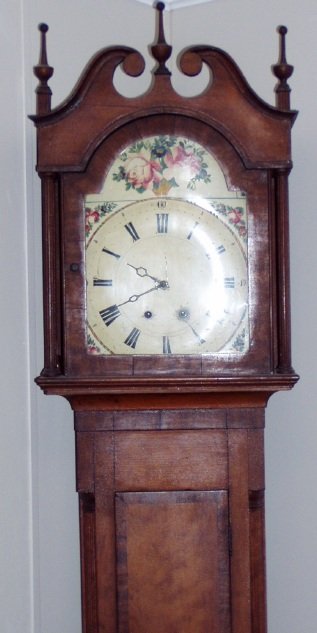
The American clock industry as we know it today, traces its roots to the very beginnings of the United States just prior to the Revolutionary War. Thomas Harland (1773 – 1807) was one of the first clockmakers in the colonies, having brought his skills with him from England when he settled in Connecticut. Harland was one of the pioneers in using standardized and interchangeable parts when making his tall case clocks. Harland’s legacy includes training Daniel Burnap (1759 – 1838), who continued to use Harland’s assembly methods. Burnap in turn trained Eli Terry (1772 – 1852) who is credited with establishing the first American clock factory around 1800. The American clock industry thrived during the 1800’s and early 1900’s, leaving
clock collectors
with thousands of examples of uniquely American clocks that are still running today. Here is a brief overview of some of the most famous American clock makers.
The Ansonia CompanyFounded in 1851, the Ansonia Clock Company was originally located in Ansonia, Connecticut but after a complex and tumultuous history moved to New York City in 1877. Ansonia clocks were manufactured in Ansonia, New York City, and Brooklyn under a variety of names such as Ansonia Brass & Copper Co., Ansonia Clock Co. or Ansonia Brass & Clock Co. Ansonia became a leading exporter of American clocks, selling clocks in over 20 countries around the globe. No matter which name appears on the label or is stamped into the works,
Ansonia clocks
are unmistakable to the clock collector. Ansonia specialized in upscale clocks, particularly statue (figurine) clocks, swinging clocks, and other novelty clocks. In 1886 the Ansonia product line included 225 different clock models while in 1914 that number expanded to 440. At the same time the company manufactured and sold over 10 million inexpensive watches between 1904 and 1929. However, the 1920’s saw the decline of this once giant in the American clock industry. All equipment was sold and moved to Russia in 1929.
The Gilbert CompanyWilliam Gilbert (1806 – 1890) was active in the American clock business in Connecticut beginning in 1828. The Gilbert Manufacturing Company existed from 1866 only until 1871 when fire destroyed the company. The company re-emerged later that year as the William L. Gilbert Clock Company. After the Great Depression the company reorganized as the William L. Gilbert Clock Corporation. The clock making business was eventually sold to the Spartus Corporation of Chicago in 1964. Gilbert clocks are known for their quality and many fine examples of
Gilbert clocks
remain as family heirlooms or as collector items.
Elias Ingraham and CompanyDue to the creative genius of members of the Ingraham family, many of the Ingraham clock designs were not to be duplicated by other American companies. Elias Ingraham, who lived from 1805 until 1885, was a noted clock case maker who received 17 U.S. patents for designs and manufacturing processes for clock cases. The graceful figure 8 designs on Ingraham clock doors is one fine example of his engineering skill and eye for appealing looks for clocks. His son, Edward Ingraham, contributed greatly to American clock case production by patenting a process of applying black enamel paint to clock cases. His paint process is responsible for the huge number of black mantel clock cases that survive in good condition today. The Ingraham name in clocks continues to survive.
The Ingraham Company
was sold to McGraw-Edison in 1967. Electric clocks continue to be made using the Ingraham trademark.
The Waterbury CompanyAnother giant of the American clock industry is the Waterbury Clock Company which was established in 1857 in Waterbury, Connecticut. Like the nearby Ansonia Company, the Waterbury Clock Company was a subsidiary of a brass manufacturer. Waterbury was another prolific producer of American clocks in the styles of the period and over 400 models of Waterbury clocks have been identified. Waterbury added pocket watches to its product line around 1890 and by 1915 Waterbury became the largest clockmaker on the American scene. Over the decades, the company also introduced the original Mickey Mouse wristwatch to Americans of all ages. The ravages of the Great Depression combined with the impact of World War II on domestic production caused the company to be sold to investors from Norway who changed the name to United States Time Corporation whose claim to fame is the Timex brand of watches. But clock collectors still prize the antique clocks of the
Waterbury Company
that were made during the heyday of the American clock industry from the 1850’s until the 1920’s.
The New Haven Company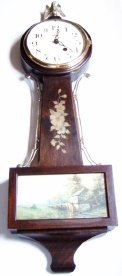
The New Haven Clock Company
started in 1853. They were incorporated to produce cheap brass movements for the
Jerome Manufacturing Company.
Two years later, Jerome went bankrupt and The New Haven Clock Company purchased it. The company did well from the mid-1850's until the 1880's manufacturing complete clocks and also a line of inexpensive pocket watches, which were produced until 1956. The company made French clocks, regulators, wall clocks, cabinet clocks, calendar clocks, figurine clocks, and tall case clocks.
New Haven
was one of the largest clock manufactures in America. Financial trouble finally caused operations to cease in 1959.
The Seth Thomas Company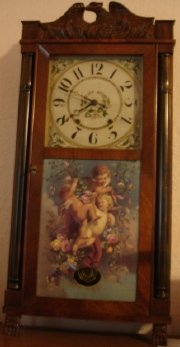
No discussion of American clocks would be complete without mentioning one of the most famous names of all; The Seth Thomas Clock Company. Seth Thomas started as a partnership with Silas Hoadley in 1810 when the two bought Eli Terry's plant near Waterbury Ct. Three years later, Seth Thomas (1786 -1859)sold out to Hoadley and started his own plant in Plymouth Hollow, Connecticut where he made tall case clocks with wooden movements. Thomas was not a great inventor. He was slow to change his clock designs and mostly waited until he saw another company have success with a particular style of clock before he would finally, though reluctantly, start making them himself. What made Seth Thomas one of the most successful clock companies in the world was his great business abilities. After Thomas' death in 1859, his three sons took over the company. Seth Thomas was so respected in Plymouth Hollow, that six years after his death, the residents voted to change the towns name to Thomaston, Connecticut. The company stayed in the Thomas family until the death of Seth's great grandson, Seth E. Thomas, Jr. in 1932. One year prior to his death, however, the company was bought by General Time Instruments Corporation, with Seth E. Thomas, Jr. staying on as chairman of the board until his death. In 1970, The
Seth Thomas
Clock Company became a division of Talley Industries.
E.N.Welch Manufacturing Company / Sessions Clock Company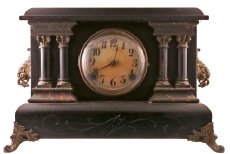
Elisha Niles Welch (1809-1887) bought the Forrestville Company from J.C. Brown, and two other failing companies and formed The Welch, Spring and Company in 1868. Elisha died in 1887 and his son, James became president. Fire destroyed the movement factory in 1899 and later that same year, the case factory was also destroyed by fire. Financial woes followed and in 1902 the company was taken over by William E. Sessions and in 1903 the name of the company was changed to The Sessions Clock Company. The Sessions Company continued to manufacture E.N. Welch's clocks until about 1936, when they stopped making spring driven clocks and turned to the new electric clock. The company was successful for many years until they lost over a million dollars in 1958 and was sold to Consolidated Electronics Industries Corporation of New York. They continued to make electric clocks in Forrestville, Connecticut with the Sessions name until 1968 when the company was again sold. The new owners, United Metal Goods Company of Brooklyn, New York, also made electric clocks and coffee makers. They stopped production in Forrestville, and sold the buildings. This was not the end of the Sessions reign in clock making however. In 1958, W.K. Sessions formed
The New England Clock Company.
They made quality clocks with beautiful cases until about 2000, when they closed their plant. Unlike
Sessions,
New England purchased many of their movements abroad, mostly from Germany.
General TrendThese are just some of the great names in American clock making. Don’t forget other famous American companies like Chauncey Jerome, Eli Terry, Chelsea, Herschede Hall Clock, Howard Miller, Hermle, New England, Lux Manufacturing, and Westclox. In all there were over 30 major clock companies in America during the premier days of the industry in the 1800’s until about 1920. Factors that shaped the American scene affected all the clock companies and contributed to the demise of the industry. The Great Depression of the 1930’s reduced discretionary spending so the American public was not buying clocks and watches. Any clock company that survived the economic depression was influenced by World War II. The U.S. government converted many manufacturing plants, especially those with metalworking capabilities like the clock companies, to producers of materials for war. These two major impacts are seen in the demise of each of the American clock companies that survived through the end of World War II, never to regain their prior prominence. However, clock enthusiasts can continue to celebrate the great years of the American clock industry by preserving the clocks and the history of the American clock companies . For more information about these companies, or clock collecting in general, see Clock Collecting Tips' back issues. Still need more information?
One of the best places to find all kinds of antique, or collectible clocks is on eBay. They have thousands of listings every day where you may find just the clock you're looking for. New to eBay? It's easy and only takes a few minutes. See what's available right now in the box below. (You can type anything you want in the eBay search box below.) |




